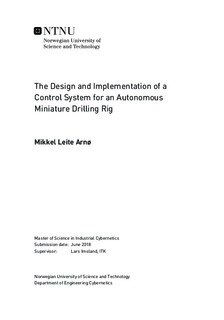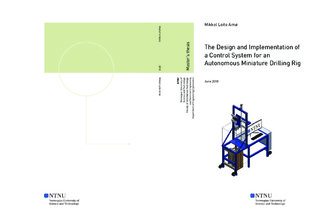| dc.description.abstract | The work presented in this thesis is concerned with the control system of the autonomous miniature drilling rig NTNU has entered and competed with in the international Drillbotics competition. A brief listing of the status of automation in the drilling industry is given, along with challenges, both current and in the future. Furthermore, relevant theory regarding digital filter design, Cohen-Coon PID tuning and least squares estimation is provided for a deeper understanding of the various aspects of the design.
The entire implementation of the system is given, including a brief introduction to LabVIEW and the underlying motivation for choosing this software. An overview of the setup provides the details revolving hardware, software and communication protocols in the design, including actuators and sensors. The process of selecting sampling frequency and the self-coding of digital third-order Butterworth filters is explained. Then, an overview of the various control schemes is given before explaining a fully autonomous state machine, of which a simplified version was used on the competition day. As the team's work is handed over to next year's team, measures to document data well, along with modularizing and describing the LabVIEW code well have been taken. Also, the graphical user interface for the autonomous program is presented separately, explaining the train of thought when coming up with a user-friendly design. Safety has been a priority during this project, so a shutdown sequence also functioning as an emergency shutdown has been implemented in all LabVIEW programs. As previously mentioned, documenting results has also been a priority, which is why an automatic file saving module was coded and implemented in all programs to systematically save all drilling data.
After the implementation is explained, the results of the most important tests are presented. This includes limit tests, PID controller tuning, formation response tests to determine drilling parameters to move forward with and estimator tests to identify drilled formation. Finally, the crown of the work, the results for the two state machines are discussed. One section includes the Drillbotics competition drilling session, where the simplified state machine without the estimator was used. The final section elaborates on a drilling run performed after the competition, where the estimator is put to the test. | |

